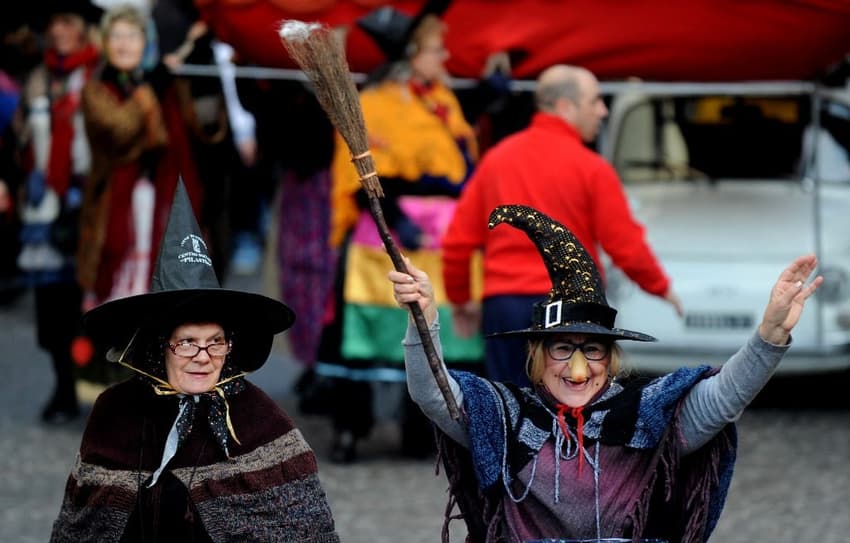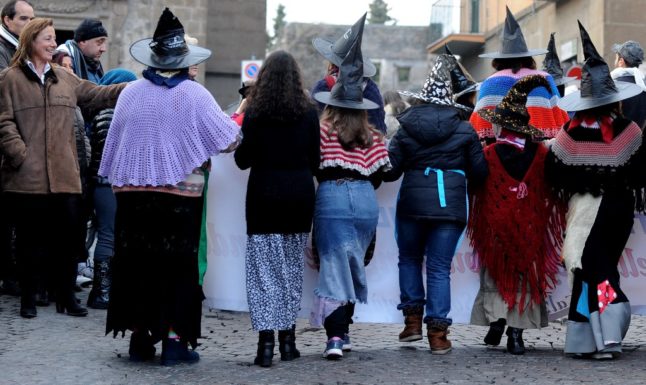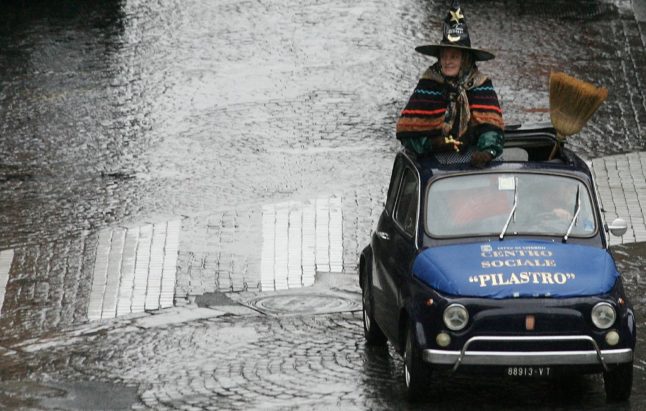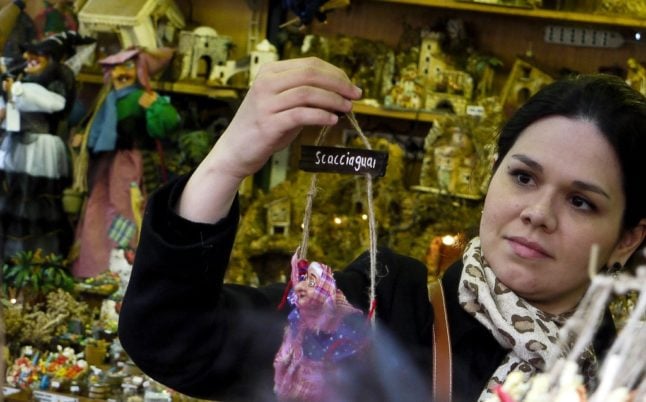Pagan witches and Mussolini: Why Italy's Epiphany holiday has a curious history

Italy celebrates Befana on January 6th, a holiday that rivals Christmas for many Italians. But how did this staunchly Catholic nation come to worship a pagan witch? On January 6th Italians celebrate La Befana, an ugly witch with a crooked nose, a huge chin wart, hunchback and torn shoes who flies the night skies on a broom, rewarding or punishing kids depending on how they’ve behaved.
In the morning, Italian children rush to the fireplace to see what La Befana has left in their stockings: sweets and chocolates if they’ve been good, often also money, or ‘charcoal’ (black sugar lumps) if naughty.
READ ALSO: How to make the most of Italy’s public holidays in 2023
It’s a deeply felt, nationalist holiday. In Piedmont, Befana scarecrows are burned to bless the new year; in Lazio locals do the ‘Befana Dive’, a swim in the cold sea, while women jokingly call each other ‘Befana’ and dress up as witches. In many villages, city piazzas and alleys there are Befana-themed masked parades.
But how did such a Catholic nation come to worship a pagan witch?
Its origins date back to Ancient Roman times, when it was real party. Families and friends would get together at the taberna (‘tavern’) to feast, and would also buy cakes to bring to other people’s homes as gifts.
“According to the beliefs of our Roman ancestors, on the night of January 6th female deities flew over the cultivated fields to boost the soil’s fertility and yield,” explains historian and archaeologist Giorgio Franchetti, author of several books on the Ancient Romans.
“Such goddesses had many different names. Initially it was Diana, who is not only the goddess of hunting but also of vegetation and nature, then there was Satia (deity of satiety) and Abundia (goddess of abundance), all beautiful women who physically had nothing in common with the old granny stereotype embodied by modern Befana.”

People dress up as witches during an Epiphany parade - but the original 'Befana' was said to be an attractive young female deity. (Photo by TIZIANA FABI / AFP)The rural nature of the flying sorceresses was linked to the nocturnal setting during which these fertility rituals were carried out, with a shining moon and in the countryside and woods, which are all elements sacred to Diana.
Similarly, La Befana lands on roofs at night and slides down the chimney, but today she’s a domestic, homey-looking character who’s no longer confined to rural areas.
“January 6th was a special day for the Ancient Romans as it ended the 12-day festivity period that followed December 25th, when they celebrated the birth in a cave of God Mithras whose story resembles that of Jesus Christ,” says Franchetti.
“It was also the day of the Sol Invictus, the ‘invincible sun’, for December 25th marked the end of the dark winter days that started to become brighter and longer.
“This entire period celebrated the beginning of a new year, of prosperity and welcomed the upcoming spring.”

In Italy Epiphany is celebrated with the tradition of La Befana, an old woman, bringing presents to children during the night of January 5th. (Photo by TIZIANA FABI / AFP)When Christianity and the Church came along, these young sexy flying pagan goddesses were condemned and banned from worship. No longer accepted as bringers of good omen and prosperity, they were turned into outcast, terrifying witches and classified as ‘evil’.
They became old, freakish carriers of ill-omen, and thus also of charcoal, which is the symbol of the bonfire on which alleged witches were later burnt at the stake by the Holy Inquisition.
“The church tried to obliterate all pre-Christian rituals and festivities by overlapping these with the celebration of the Christian Epiphany, which is when the three wise men meet baby Jesus bearing gifts”, says Franchetti.
Centuries later La Befana found her greatest fan in Mussolini, who promoted her as an all-Italian, patriotic female alternative to the foreign Father Christmas.
Mussolini had a specific reason for making her the Christmas queen. He banned all foreign-sounding and English-related words and traditions, and saw Santa Claus as an outsider to Italian culture.
The tyrant thus substituted the ‘imported’, Anglo-Saxon Father Christmas with the Italian Befana, who has been roaming the night skies since the dawn of time.

A street seller holds a Befana doll at a market in Rome’s Piazza Navona. (Photo by ANDREAS SOLARO / AFP)In 1928 Mussolini, with the help of the regime’s propaganda, established Epifania as a national holiday. It was called La Befana Romana, or La Befana Fascista.
“It was typical of the regime to appropriate pagan and Roman myths or symbols as means of glorification and power”, says Franchetti.
Inspired by the ideal of great ancient Rome, Mussolini quite cleverly adapted and adopted pagan flying goddesses to his own ends.
Italian elders still recall when their mothers and grandmothers during the fascist regime would gather piles of old clothes, socks and toys to give to the poor and to homeless orphans.
“It was part of the fascist regime’s pro-welfare propaganda. My mom would go through our wardrobe telling us to help her gather what we no longer needed so as to obey the call from authorities prompting families to be generous to those in need”, recalls 95-year-old Giulio Verde, a Roman pensioner.
“On TV and radio the regime appealed to rich people in particular to offer food and old clothes to the poor and homeless through national welfare campaigns led by juvenile associations that hailed fascism’s social mission and honored Mussolini”, adds Verde.
However, La Befana’s popularity survived fascism and found supporters even after the end of World War II, as she embodied the positive, familiar image of the gift-bearer. Political parties continued using the Befana as a propaganda tool to promote their policies in favor of poor families.
Italians also adore her because she allows us to stretch the Christmas holidays out until January 6th - and beyond if the festivity happens to fall on a Friday like this year. We have a rhyming phrase to wish her ciao ciao: “…Eh l’Epifania, che tutte le feste si porta via” (and so the epiphany brushes away all festivities).
Comments
See Also
On January 6th Italians celebrate La Befana, an ugly witch with a crooked nose, a huge chin wart, hunchback and torn shoes who flies the night skies on a broom, rewarding or punishing kids depending on how they’ve behaved.
In the morning, Italian children rush to the fireplace to see what La Befana has left in their stockings: sweets and chocolates if they’ve been good, often also money, or ‘charcoal’ (black sugar lumps) if naughty.
READ ALSO: How to make the most of Italy’s public holidays in 2023
It’s a deeply felt, nationalist holiday. In Piedmont, Befana scarecrows are burned to bless the new year; in Lazio locals do the ‘Befana Dive’, a swim in the cold sea, while women jokingly call each other ‘Befana’ and dress up as witches. In many villages, city piazzas and alleys there are Befana-themed masked parades.
But how did such a Catholic nation come to worship a pagan witch?
Its origins date back to Ancient Roman times, when it was real party. Families and friends would get together at the taberna (‘tavern’) to feast, and would also buy cakes to bring to other people’s homes as gifts.
“According to the beliefs of our Roman ancestors, on the night of January 6th female deities flew over the cultivated fields to boost the soil’s fertility and yield,” explains historian and archaeologist Giorgio Franchetti, author of several books on the Ancient Romans.
“Such goddesses had many different names. Initially it was Diana, who is not only the goddess of hunting but also of vegetation and nature, then there was Satia (deity of satiety) and Abundia (goddess of abundance), all beautiful women who physically had nothing in common with the old granny stereotype embodied by modern Befana.”

The rural nature of the flying sorceresses was linked to the nocturnal setting during which these fertility rituals were carried out, with a shining moon and in the countryside and woods, which are all elements sacred to Diana.
Similarly, La Befana lands on roofs at night and slides down the chimney, but today she’s a domestic, homey-looking character who’s no longer confined to rural areas.
“January 6th was a special day for the Ancient Romans as it ended the 12-day festivity period that followed December 25th, when they celebrated the birth in a cave of God Mithras whose story resembles that of Jesus Christ,” says Franchetti.
“It was also the day of the Sol Invictus, the ‘invincible sun’, for December 25th marked the end of the dark winter days that started to become brighter and longer.
“This entire period celebrated the beginning of a new year, of prosperity and welcomed the upcoming spring.”

When Christianity and the Church came along, these young sexy flying pagan goddesses were condemned and banned from worship. No longer accepted as bringers of good omen and prosperity, they were turned into outcast, terrifying witches and classified as ‘evil’.
They became old, freakish carriers of ill-omen, and thus also of charcoal, which is the symbol of the bonfire on which alleged witches were later burnt at the stake by the Holy Inquisition.
“The church tried to obliterate all pre-Christian rituals and festivities by overlapping these with the celebration of the Christian Epiphany, which is when the three wise men meet baby Jesus bearing gifts”, says Franchetti.
Centuries later La Befana found her greatest fan in Mussolini, who promoted her as an all-Italian, patriotic female alternative to the foreign Father Christmas.
Mussolini had a specific reason for making her the Christmas queen. He banned all foreign-sounding and English-related words and traditions, and saw Santa Claus as an outsider to Italian culture.
The tyrant thus substituted the ‘imported’, Anglo-Saxon Father Christmas with the Italian Befana, who has been roaming the night skies since the dawn of time.

In 1928 Mussolini, with the help of the regime’s propaganda, established Epifania as a national holiday. It was called La Befana Romana, or La Befana Fascista.
“It was typical of the regime to appropriate pagan and Roman myths or symbols as means of glorification and power”, says Franchetti.
Inspired by the ideal of great ancient Rome, Mussolini quite cleverly adapted and adopted pagan flying goddesses to his own ends.
Italian elders still recall when their mothers and grandmothers during the fascist regime would gather piles of old clothes, socks and toys to give to the poor and to homeless orphans.
“It was part of the fascist regime’s pro-welfare propaganda. My mom would go through our wardrobe telling us to help her gather what we no longer needed so as to obey the call from authorities prompting families to be generous to those in need”, recalls 95-year-old Giulio Verde, a Roman pensioner.
“On TV and radio the regime appealed to rich people in particular to offer food and old clothes to the poor and homeless through national welfare campaigns led by juvenile associations that hailed fascism’s social mission and honored Mussolini”, adds Verde.
However, La Befana’s popularity survived fascism and found supporters even after the end of World War II, as she embodied the positive, familiar image of the gift-bearer. Political parties continued using the Befana as a propaganda tool to promote their policies in favor of poor families.
Italians also adore her because she allows us to stretch the Christmas holidays out until January 6th - and beyond if the festivity happens to fall on a Friday like this year. We have a rhyming phrase to wish her ciao ciao: “…Eh l’Epifania, che tutte le feste si porta via” (and so the epiphany brushes away all festivities).
Join the conversation in our comments section below. Share your own views and experience and if you have a question or suggestion for our journalists then email us at [email protected].
Please keep comments civil, constructive and on topic – and make sure to read our terms of use before getting involved.
Please log in here to leave a comment.